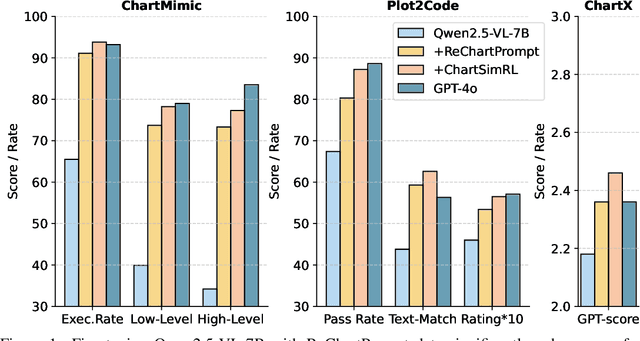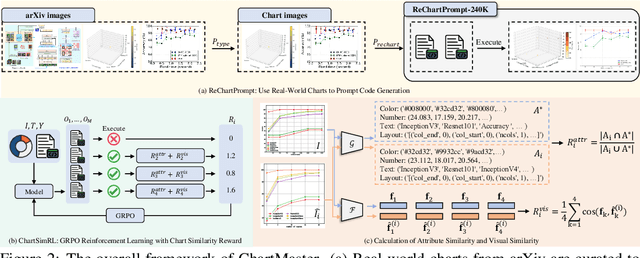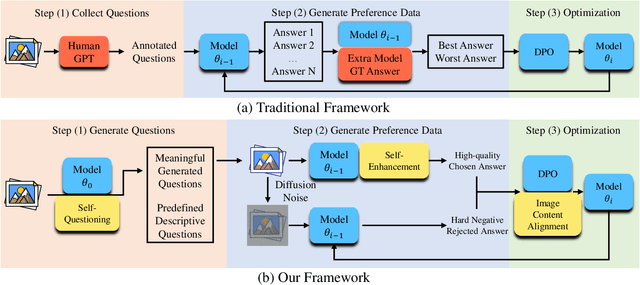Yibing Zhan
ChartMaster: Advancing Chart-to-Code Generation with Real-World Charts and Chart Similarity Reinforcement Learning
Aug 25, 2025



Abstract:The chart-to-code generation task requires MLLMs to convert chart images into executable code. This task faces two major challenges: limited data diversity and insufficient maintenance of visual consistency between generated and original charts during training. Existing datasets mainly rely on seed data to prompt GPT models for code generation, resulting in homogeneous samples. To address this, we propose ReChartPrompt, which leverages real-world, human-designed charts from arXiv papers as prompts instead of synthetic seeds. Using the diverse styles and rich content of arXiv charts, we construct ReChartPrompt-240K, a large-scale and highly diverse dataset. Another challenge is that although SFT effectively improve code understanding, it often fails to ensure that generated charts are visually consistent with the originals. To address this, we propose ChartSimRL, a GRPO-based reinforcement learning algorithm guided by a novel chart similarity reward. This reward consists of attribute similarity, which measures the overlap of chart attributes such as layout and color between the generated and original charts, and visual similarity, which assesses similarity in texture and other overall visual features using convolutional neural networks. Unlike traditional text-based rewards such as accuracy or format rewards, our reward considers the multimodal nature of the chart-to-code task and effectively enhances the model's ability to accurately reproduce charts. By integrating ReChartPrompt and ChartSimRL, we develop the ChartMaster model, which achieves state-of-the-art results among 7B-parameter models and even rivals GPT-4o on various chart-to-code generation benchmarks. All resources are available at https://github.com/WentaoTan/ChartMaster.
Bi-Level Optimization for Self-Supervised AI-Generated Face Detection
Jul 30, 2025



Abstract:AI-generated face detectors trained via supervised learning typically rely on synthesized images from specific generators, limiting their generalization to emerging generative techniques. To overcome this limitation, we introduce a self-supervised method based on bi-level optimization. In the inner loop, we pretrain a vision encoder only on photographic face images using a set of linearly weighted pretext tasks: classification of categorical exchangeable image file format (EXIF) tags, ranking of ordinal EXIF tags, and detection of artificial face manipulations. The outer loop then optimizes the relative weights of these pretext tasks to enhance the coarse-grained detection of manipulated faces, serving as a proxy task for identifying AI-generated faces. In doing so, it aligns self-supervised learning more closely with the ultimate goal of AI-generated face detection. Once pretrained, the encoder remains fixed, and AI-generated faces are detected either as anomalies under a Gaussian mixture model fitted to photographic face features or by a lightweight two-layer perceptron serving as a binary classifier. Extensive experiments demonstrate that our detectors significantly outperform existing approaches in both one-class and binary classification settings, exhibiting strong generalization to unseen generators.
Re-Initialization Token Learning for Tool-Augmented Large Language Models
Jun 17, 2025Abstract:Large language models have demonstrated exceptional performance, yet struggle with complex tasks such as numerical reasoning, plan generation. Integrating external tools, such as calculators and databases, into large language models (LLMs) is crucial for enhancing problem-solving capabilities. Current methods assign a unique token to each tool, enabling LLMs to call tools through token prediction-similar to word generation. However, this approach fails to account for the relationship between tool and word tokens, limiting adaptability within pre-trained LLMs. To address this issue, we propose a novel token learning method that aligns tool tokens with the existing word embedding space from the perspective of initialization, thereby enhancing model performance. We begin by constructing prior token embeddings for each tool based on the tool's name or description, which are used to initialize and regularize the learnable tool token embeddings. This ensures the learned embeddings are well-aligned with the word token space, improving tool call accuracy. We evaluate the method on tasks such as numerical reasoning, knowledge-based question answering, and embodied plan generation using GSM8K-XL, FuncQA, KAMEL, and VirtualHome datasets. The results demonstrate clear improvements over recent baselines, including CoT, REACT, ICL, and ToolkenGPT, indicating that our approach effectively augments LLMs with tools through relevant tokens across diverse domains.
Reverse Prompt: Cracking the Recipe Inside Text-to-Image Generation
Mar 25, 2025Abstract:Text-to-image generation has become increasingly popular, but achieving the desired images often requires extensive prompt engineering. In this paper, we explore how to decode textual prompts from reference images, a process we refer to as image reverse prompt engineering. This technique enables us to gain insights from reference images, understand the creative processes of great artists, and generate impressive new images. To address this challenge, we propose a method known as automatic reverse prompt optimization (ARPO). Specifically, our method refines an initial prompt into a high-quality prompt through an iteratively imitative gradient prompt optimization process: 1) generating a recreated image from the current prompt to instantiate its guidance capability; 2) producing textual gradients, which are candidate prompts intended to reduce the difference between the recreated image and the reference image; 3) updating the current prompt with textual gradients using a greedy search method to maximize the CLIP similarity between prompt and reference image. We compare ARPO with several baseline methods, including handcrafted techniques, gradient-based prompt tuning methods, image captioning, and data-driven selection method. Both quantitative and qualitative results demonstrate that our ARPO converges quickly to generate high-quality reverse prompts. More importantly, we can easily create novel images with diverse styles and content by directly editing these reverse prompts. Code will be made publicly available.
End-to-End HOI Reconstruction Transformer with Graph-based Encoding
Mar 08, 2025



Abstract:With the diversification of human-object interaction (HOI) applications and the success of capturing human meshes, HOI reconstruction has gained widespread attention. Existing mainstream HOI reconstruction methods often rely on explicitly modeling interactions between humans and objects. However, such a way leads to a natural conflict between 3D mesh reconstruction, which emphasizes global structure, and fine-grained contact reconstruction, which focuses on local details. To address the limitations of explicit modeling, we propose the End-to-End HOI Reconstruction Transformer with Graph-based Encoding (HOI-TG). It implicitly learns the interaction between humans and objects by leveraging self-attention mechanisms. Within the transformer architecture, we devise graph residual blocks to aggregate the topology among vertices of different spatial structures. This dual focus effectively balances global and local representations. Without bells and whistles, HOI-TG achieves state-of-the-art performance on BEHAVE and InterCap datasets. Particularly on the challenging InterCap dataset, our method improves the reconstruction results for human and object meshes by 8.9% and 8.6%, respectively.
An Atomic Skill Library Construction Method for Data-Efficient Embodied Manipulation
Jan 25, 2025



Abstract:Embodied manipulation is a fundamental ability in the realm of embodied artificial intelligence. Although current embodied manipulation models show certain generalizations in specific settings, they struggle in new environments and tasks due to the complexity and diversity of real-world scenarios. The traditional end-to-end data collection and training manner leads to significant data demands, which we call ``data explosion''. To address the issue, we introduce a three-wheeled data-driven method to build an atomic skill library. We divide tasks into subtasks using the Vision-Language Planning (VLP). Then, atomic skill definitions are formed by abstracting the subtasks. Finally, an atomic skill library is constructed via data collection and Vision-Language-Action (VLA) fine-tuning. As the atomic skill library expands dynamically with the three-wheel update strategy, the range of tasks it can cover grows naturally. In this way, our method shifts focus from end-to-end tasks to atomic skills, significantly reducing data costs while maintaining high performance and enabling efficient adaptation to new tasks. Extensive experiments in real-world settings demonstrate the effectiveness and efficiency of our approach.
Leveraging Metamemory Mechanisms for Enhanced Data-Free Code Generation in LLMs
Jan 14, 2025



Abstract:Automated code generation using large language models (LLMs) has gained attention due to its efficiency and adaptability. However, real-world coding tasks or benchmarks like HumanEval and StudentEval often lack dedicated training datasets, challenging existing few-shot prompting approaches that rely on reference examples. Inspired by human metamemory-a cognitive process involving recall and evaluation-we present a novel framework (namely M^2WF) for improving LLMs' one-time code generation. This approach enables LLMs to autonomously generate, evaluate, and utilize synthetic examples to enhance reliability and performance. Unlike prior methods, it minimizes dependency on curated data and adapts flexibly to various coding scenarios. Our experiments demonstrate significant improvements in coding benchmarks, offering a scalable and robust solution for data-free environments. The code and framework will be publicly available on GitHub and HuggingFace.
Modeling All Response Surfaces in One for Conditional Search Spaces
Jan 08, 2025Abstract:Bayesian Optimization (BO) is a sample-efficient black-box optimizer commonly used in search spaces where hyperparameters are independent. However, in many practical AutoML scenarios, there will be dependencies among hyperparameters, forming a conditional search space, which can be partitioned into structurally distinct subspaces. The structure and dimensionality of hyperparameter configurations vary across these subspaces, challenging the application of BO. Some previous BO works have proposed solutions to develop multiple Gaussian Process models in these subspaces. However, these approaches tend to be inefficient as they require a substantial number of observations to guarantee each GP's performance and cannot capture relationships between hyperparameters across different subspaces. To address these issues, this paper proposes a novel approach to model the response surfaces of all subspaces in one, which can model the relationships between hyperparameters elegantly via a self-attention mechanism. Concretely, we design a structure-aware hyperparameter embedding to preserve the structural information. Then, we introduce an attention-based deep feature extractor, capable of projecting configurations with different structures from various subspaces into a unified feature space, where the response surfaces can be formulated using a single standard Gaussian Process. The empirical results on a simulation function, various real-world tasks, and HPO-B benchmark demonstrate that our proposed approach improves the efficacy and efficiency of BO within conditional search spaces.
Self-Supervised Learning for Detecting AI-Generated Faces as Anomalies
Jan 04, 2025



Abstract:The detection of AI-generated faces is commonly approached as a binary classification task. Nevertheless, the resulting detectors frequently struggle to adapt to novel AI face generators, which evolve rapidly. In this paper, we describe an anomaly detection method for AI-generated faces by leveraging self-supervised learning of camera-intrinsic and face-specific features purely from photographic face images. The success of our method lies in designing a pretext task that trains a feature extractor to rank four ordinal exchangeable image file format (EXIF) tags and classify artificially manipulated face images. Subsequently, we model the learned feature distribution of photographic face images using a Gaussian mixture model. Faces with low likelihoods are flagged as AI-generated. Both quantitative and qualitative experiments validate the effectiveness of our method. Our code is available at \url{https://github.com/MZMMSEC/AIGFD_EXIF.git}.
Beyond Human Data: Aligning Multimodal Large Language Models by Iterative Self-Evolution
Dec 20, 2024



Abstract:Human preference alignment can greatly enhance Multimodal Large Language Models (MLLMs), but collecting high-quality preference data is costly. A promising solution is the self-evolution strategy, where models are iteratively trained on data they generate. However, current techniques still rely on human- or GPT-annotated data and sometimes require additional models or ground truth answers. To address these issues, we propose a novel multimodal self-evolution framework that enables the model to autonomously generate high-quality questions and answers using only unannotated images. First, we implement an image-driven self-questioning mechanism, allowing the model to create and evaluate questions based on image content, regenerating them if they are irrelevant or unanswerable. This sets a strong foundation for answer generation. Second, we introduce an answer self-enhancement technique, starting with image captioning to improve answer quality. We also use corrupted images to generate rejected answers, forming distinct preference pairs for optimization. Finally, we incorporate an image content alignment loss function alongside Direct Preference Optimization (DPO) loss to reduce hallucinations, ensuring the model focuses on image content. Experiments show that our framework performs competitively with methods using external information, offering a more efficient and scalable approach to MLLMs.
 Add to Chrome
Add to Chrome Add to Firefox
Add to Firefox Add to Edge
Add to Edge